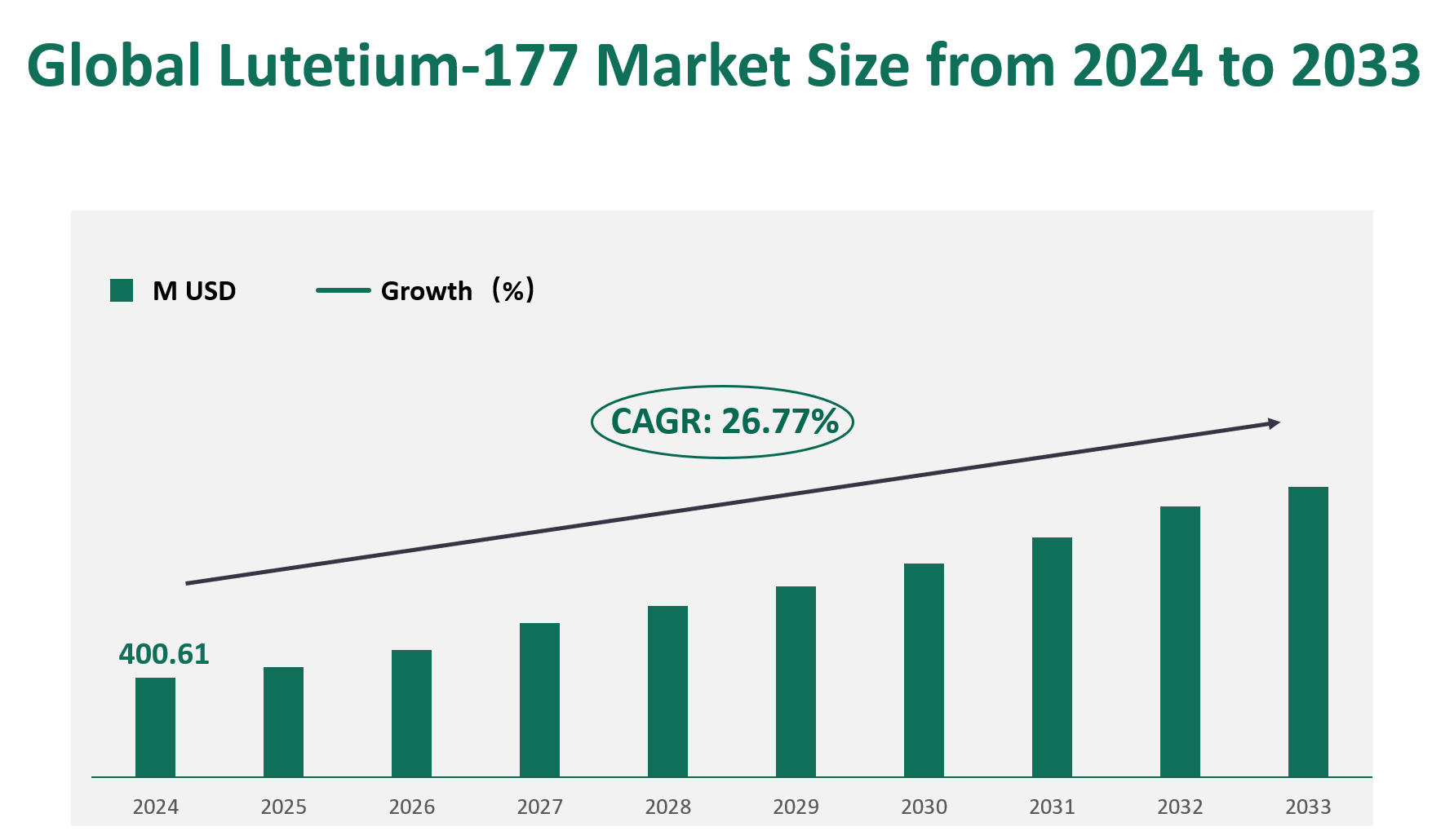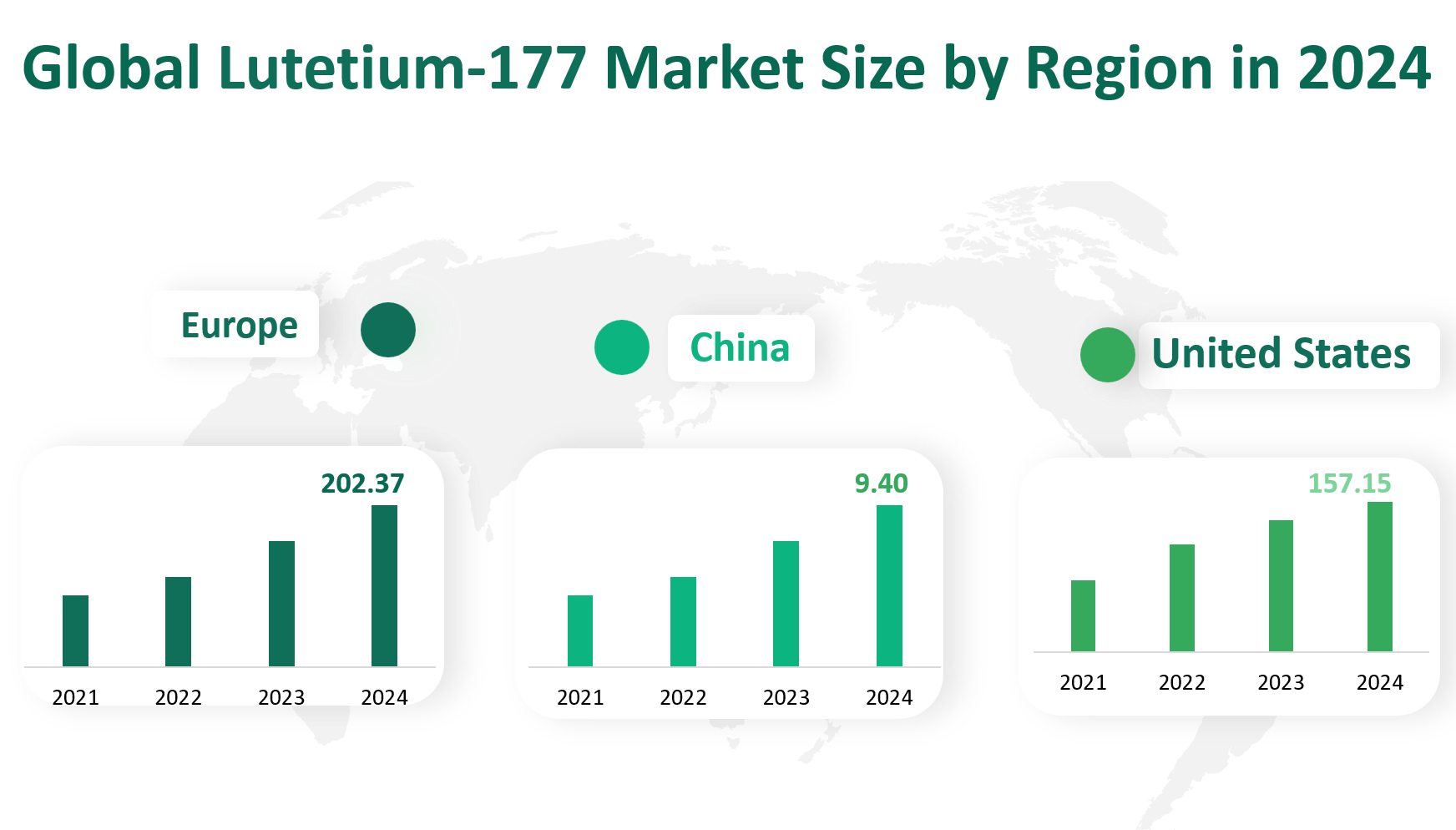1. Global Lutetium-177 Market Insight Analysis
The global Lutetium-177 (Lu-177) market is projected to reach a revenue of $400.61 million in 2024, with a robust Compound Annual Growth Rate (CAGR) of 26.77% from 2024 to 2033.
Lutetium-177 is a therapeutic radiopharmaceutical that has gained significant attention in the medical field due to its unique properties. It is a radioactive isotope with a half-life of approximately 6.65 days, making it ideal for targeted radionuclide therapy. Lu-177 emits beta particles that can deliver precise radiation to cancer cells while minimizing damage to surrounding healthy tissues. This makes it particularly effective in treating neuroendocrine tumors and prostate cancer. Additionally, Lu-177 can be used in diagnostic imaging, further enhancing its utility in the medical field. The ability to bind to specific biomolecules allows Lu-177 to be used in both therapeutic and diagnostic applications, making it a versatile tool in nuclear medicine.
Figure Global Lutetium-177 Market Size (M USD) and CAGR (2024-2033)

2. Driving and Limiting Factors of Lutetium-177 Market Growth
The growth of the Lutetium-177 market is driven by several key factors. Firstly, the increasing prevalence of cancer worldwide has created a significant demand for effective treatments. According to the World Health Organization, cancer is the second leading cause of death globally, and the number of cancer cases is expected to rise. This has spurred the development and adoption of new and innovative cancer therapies, including those involving Lu-177.
Another driving factor is the increasing investment in the development of new therapeutic and diagnostic drugs. Governments, private investors, and pharmaceutical companies are pouring resources into research and development to create more targeted and effective treatments for cancer. The development of novel theragnostics, which combine diagnostic imaging with targeted radiation therapy, is a major trend in the industry. Lu-177 is at the forefront of this trend, with several new therapies and indications currently in clinical trials.
However, the market also faces several limiting factors. One of the primary challenges is the high entry barriers due to the technical and financial requirements of producing radiopharmaceuticals. The production of Lu-177 requires specialized equipment, trained personnel, and strict regulatory compliance. Additionally, the short half-life of Lu-177 necessitates efficient production and distribution networks to ensure the availability of the product.
Another limiting factor is the high cost and potential side effects associated with Lu-177 treatments. The high radiation levels and potential side effects such as nausea, vomiting, and fatigue can limit patient acceptance, particularly in developing countries where healthcare resources may be limited. Furthermore, the regulatory approval process for radiopharmaceuticals is lengthy and complex, which can delay the introduction of new products to the market.
3. Technology Innovation and Corporate Mergers and Acquisitions in Lutetium-177 Market
The Lutetium-177 market is characterized by continuous technological innovation and strategic corporate activities. One of the key trends is the development of new production technologies that aim to increase the efficiency and purity of Lu-177 production. For example, SHINE Technologies has developed a process that eliminates the need for a nuclear reactor, potentially reducing production costs and increasing supply.
Corporate mergers and acquisitions are also playing a significant role in shaping the market. Major players such as Novartis have been actively expanding their portfolios through strategic acquisitions. For instance, Novartis acquired Advanced Accelerator Applications (AAA) to strengthen its presence in the oncology market. This acquisition has allowed Novartis to leverage AAA’s expertise in radiopharmaceuticals and expand its pipeline of targeted therapies.
Additionally, several companies are investing in the expansion of their production capacities to meet the growing global demand for Lu-177. Eczacıbaşı Monrol, for example, announced a €35 million investment to increase its production capacity for non-carrier-added Lu-177. Similarly, ITM Isotope opened the world’s largest Lu-177 production facility in Germany, aiming to significantly increase its supply capabilities.
4. Global Lutetium-177 Market Size by Type
High Specific Activity Lutetium-177 has a higher ratio of radioactivity to its mass, making it particularly effective for targeted radiation therapy. It is used in advanced treatments such as Prostate-Specific Membrane Antigen (PSMA)-targeted therapies for prostate cancer.
General Lutetium-177 has a lower specific activity compared to the high specific activity variant. It is used in a broader range of applications, including general nuclear medicine procedures.
The market revenue for high specific activity Lu-177 is projected to be $361.73 million in 2024.
The market revenue for general Lu-177 is estimated at $38.87 million in 2024.
The high specific activity Lu-177 dominates the market with a projected market share of approximately 90.30% in 2024. This dominance is attributed to its superior efficacy in targeted cancer treatments, particularly in the rapidly growing field of PSMA-targeted therapies for prostate cancer. The increasing prevalence of prostate cancer globally and the advancements in nuclear medicine have further propelled the demand for high specific activity Lu-177.
In contrast, general Lu-177, despite its broader application range, holds only 9.70% of the market share in 2024. Its lower specific activity limits its effectiveness in targeted therapies, making it less preferred for advanced medical treatments. However, it still plays a crucial role in general nuclear medicine procedures and diagnostic applications.
Table Global Lutetium-177 Market Size by Type in 2024
Market Size (M USD) 2024 | Market Share | |
General Lutetium-177 | 38.87 | 9.70% |
High Specific Activity Lutetium-177 | 361.73 | 90.30% |
5. Global Lutetium-177 Market Size by Application
Nuclear Therapy: This involves the use of Lu-177 in targeted radionuclide therapy for treating neuroendocrine tumors and prostate cancer. The radiopharmaceutical is designed to deliver targeted radiation to cancer cells, minimizing damage to surrounding healthy tissues.
Diagnosis: Lu-177 can bind to specific biomolecules in the body, allowing it to be used in imaging techniques to diagnose diseases. This application leverages the low-energy gamma rays emitted by Lu-177 for imaging and evaluation of radiation therapy effects.
The market revenue for Lu-177 in nuclear therapy is projected to be $371.11 million in 2024. This application holds the largest market share due to the increasing demand for effective cancer treatments and the growing prevalence of cancer globally.
The market revenue for Lu-177 in diagnostic applications is estimated at $20.26 million in 2024. While important for disease detection, its market share is significantly smaller compared to nuclear therapy.
Table Global Lutetium-177 Market Size by Application in 2024
Application | Market Size (M USD) 2024 | Market Share |
Nuclear Therapy | 371.11 | 92.64% |
Diagnosis | 20.26 | 5.06% |
Others | 9.23 | 2.30% |
6. Global Lutetium-177 Market by Top Regions
US market is projected to generate a revenue of $157.15 million in 2024. This region is characterized by advanced healthcare infrastructure, high demand for innovative cancer treatments, and significant investments in nuclear medicine research.
Europe is expected to lead the global Lutetium-177 market with a revenue of $202.37 million in 2024. The region’s strong market position is attributed to its well-established healthcare systems, high prevalence of cancer, and significant advancements in nuclear medicine.
China is projected to generate a revenue of $9.40 million in 2024. This region’s market growth is driven by the increasing prevalence of cancer, improving healthcare infrastructure, and growing investments in nuclear medicine.
The Latin American market is expected to generate a revenue of $2.01 million in 2024. While smaller compared to other regions, it is experiencing significant growth due to improving healthcare access and increasing awareness of advanced cancer treatments.
The Middle East and Africa region is projected to generate a revenue of $1.65 million in 2024. This region’s market is driven by increasing healthcare expenditure and growing demand for advanced medical treatments.
Figure Global Lutetium-177 Market Size by Region in 2024

7. Global Lutetium-177 Market Analysis by Major Players
7.1 Novartis
Introduction and Business Overview: Novartis is a global healthcare company headquartered in Switzerland, specializing in the development, manufacturing, and marketing of innovative medicines. The company operates through segments such as Innovative Medicines and Sandoz, with a strong focus on oncology and nuclear medicine.
Products Offered: Novartis offers Lutetium-177 products such as PLUVICTO® (lutetium Lu 177 vipivotide tetraxetan) for the treatment of prostate-specific membrane antigen (PSMA)-positive metastatic castration-resistant prostate cancer (mCRPC).
7.2 Eczacıbaşı Monrol
Introduction and Business Overview: Eczacıbaşı Monrol is a leading radiopharmaceutical producer based in Turkey, known for its high-quality radiopharmaceuticals and extensive global distribution network. The company has a strong presence in both diagnostic and therapeutic nuclear medicine.
Products Offered: Eczacıbaşı Monrol offers Lutetium-177 chloride radiopharmaceutical precursor solution, used for labeling molecules suitable for targeted cancer therapies.
7.3 ITM Isotope
Introduction and Business Overview: ITM Isotope Technologies Munich SE is a biotechnology and radiopharmaceutical company based in Germany, specializing in the development and production of targeted diagnostic and therapeutic radiopharmaceuticals.
Products Offered: ITM offers EndolucinBeta, a no-carrier-added (n.c.a.) lutetium-177 chloride radiopharmaceutical precursor solution for radiolabeling other medicines.
7.4 SHINE Technologies
Introduction and Business Overview: SHINE Technologies is a next-generation fusion technology company based in the United States, specializing in the production of medical isotopes for various applications, including cancer treatment.
Products Offered: SHINE offers non-carrier-added lutetium-177 for targeted cancer therapies, with a focus on high-purity production and innovative manufacturing processes.
Sales Revenue in 2024: Projected to be $30 million.
7.5 Eckert Ziegler
Introduction and Business Overview: Eckert Ziegler is a leading provider of isotope technology for medical, scientific, and industrial use, headquartered in Germany. The company focuses on applications in cancer therapy, industrial radiometry, and nuclear imaging.
Products Offered: Eckert Ziegler offers high-purity non-carrier-added lutetium-177 chloride solution for clinical and non-clinical research purposes.

